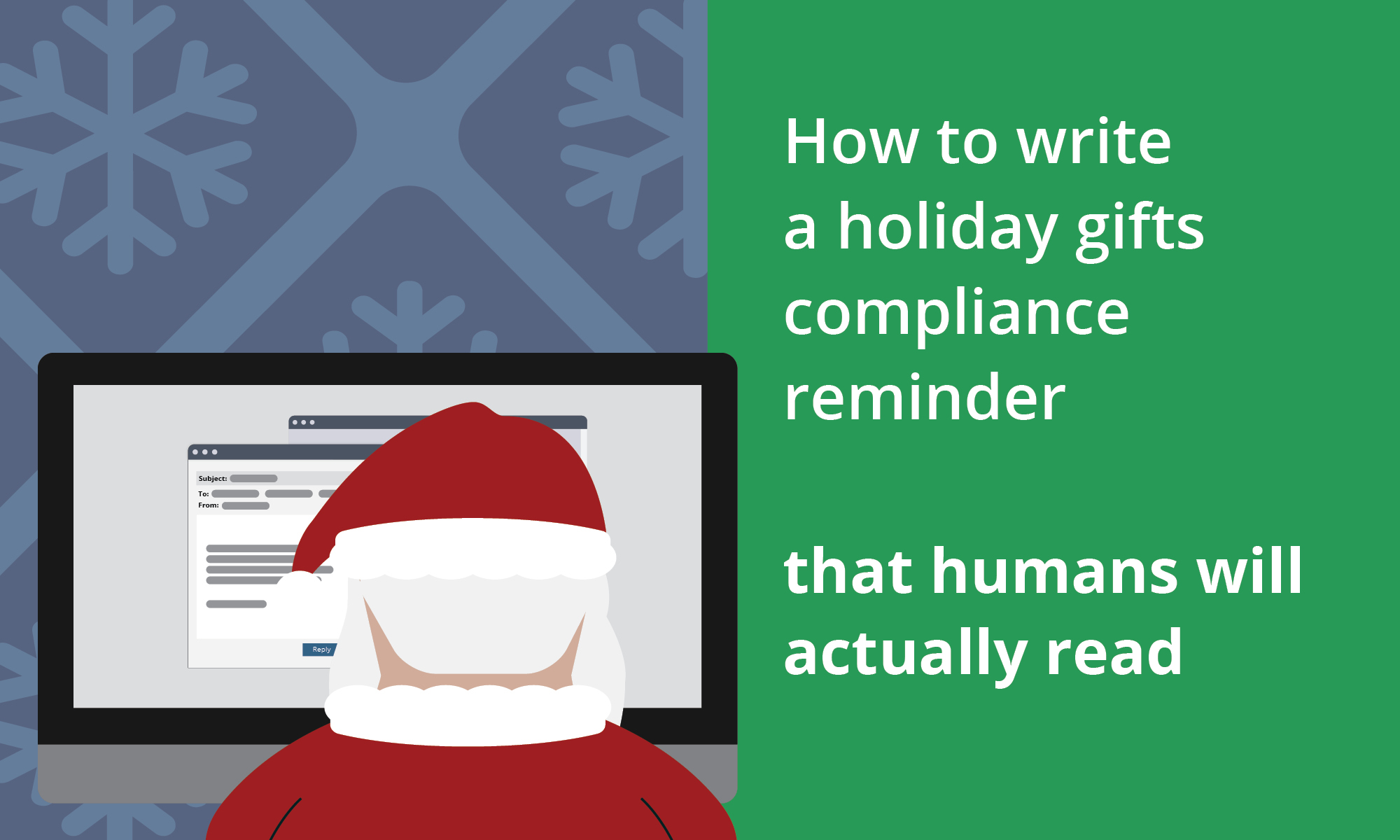
How to write a holiday gifts compliance reminder that humans will actually read
Hey guys, it’s almost Christmas, and you know what that means: TIME TO WATCH TEN MOVIES ON THE HALLMARK CHANNEL THAT ALL HAVE THE EXACT SAME PLOT!

My favorite is “Return to Sweaterton” starring Lacey Chabert.

(In this winter's Return to Sweaterton, an up-and-coming cupcake bakery owner must return to her hometown to help save her Great-Aunt's angora bunny farm from greedy land developers—all while choosing between her big-city fiance and a childhood friend.)
(No, this is not an actual movie ... yet.)
AND IT ALSO MEANS it’s time for compliance teams the world over to write reminder emails about gifts and entertainment compliance that no one will read.
And that’s because they’re written in a way that communicates to employees (and their suppliers) that the company just cares about being able to say that they told people and not whether anyone actually complies.
Here’s why—and how to craft something people will read.
How not to do this
To start, let’s look at a sample gift email, the type of thing you send to your salespeople and suppliers around this time of year.
(And just to be clear, I made this one up, but it’ll look familiar if you do this because everyone pretty much does the same thing.)
Dear valued colleagues and suppliers,
As we approach the festive season in many parts of the world, it is natural for gifts and other business courtesies to be exchanged. We are grateful for these business partnerships and appreciate the opportunity to celebrate this season by showing our mutual respect and esteem.
At the same time, as an organization committed to upholding the highest standards of integrity in our business practices, it is imperative that we avoid any situation where it could even appear that we are showing favoritism, requesting or accepting any kind of improper advantage, or otherwise engaging in conduct that is inconsistent with our values.
To that end, we want to take this opportunity to remind you of the guidelines set out in OmniCorp Consumer Products’ gifts and entertainment policy, a key way in which we safeguard the values that make us New Detroit’s most-trusted supplier of police robots.
Here are a few key principles:
- We may not exchange cash or cash equivalents such as gift cards
- All gifts must be provided only to reflect esteem or gratitude
- Gifts must be reasonable and appropriate and never lavish
- Gifts must be permitted under local law
Of course, we cannot cover every situation in an email, so we encourage you to read our gifts and entertainment policy, available at http://www.omnicorpconsumerproducts.com/backslash/garbagefile.htm, for even more guidance and regional variations.
Thank you again for your continued partnership.
Warm regards,
OCP Compliance Team
*****
Right. Pretty standard stuff.
But here’s the thing: if you want people to do something for you, make it easy. This does the opposite.
Specifically:
- It’s unnecessarily long; it takes 3 paragraphs to say “follow our rules on gifts,” and then only after you get through a bunch of corporate boilerplate. No one needs this.
- It’s vague; while some rules (“no cash”) are clear, others are just vague statements cribbed from the DOJ’s FCPA guidance. This type of thinking comes from the Hogwarts School of Compliance Wizardry, where just saying the same magic words the government uses means you’re good.
- It’s incomplete; it uses a catch-all that makes you go read the policy before you can even be sure if you’re complying or not. Sure, this is what people love doing: clicking through to read policies.
This is pretty standard stuff, and all of it is terrible. Everything about this flags that the goal is to be able to say that the compliance team warned you, not to actually help you comply. It has been optimized to make checking the box easy for the compliance team—and actual compliance difficult for the recipients.
And look: if your goal is to just check a box for insurance or governance purposes, THIS IS FINE.
 But if your goal is to actually get people to comply, you gotta do this differently.
But if your goal is to actually get people to comply, you gotta do this differently.
How to do this well
There are three basic rules to follow to make this easy for folks:
1. Get to the point.
Literally every company says “values are important.” Every. Single. One. And they all know gifts compliance is important. (And if not, these rambling corporate-speak intros aren’t going to change that.)
So, you’re good there. You don’t need to lay all that groundwork. Don’t run the risk of having people tune out before you even tell them what the issue is; lead off with letting people know that they need to follow your gifts policy, in one sentence.
2. Use a chart
Next, after your one-sentence intro, give people a chart that explains what they can and can’t do.
A CHART. Not a bulleted list of principles or a five-factor balancing test that belongs on a law school exam; A CHART, BECAUSE REGULAR PEOPLE USE CHARTS.
To be fair, a good chart is hard to make. So we've got a couple different versions of these in Compliance Design Club that our Members can download (so join now if you haven't yet).


Now, what if your gifts policy is too complex to put into a simple chart?
It’s a bad policy, start over.
Yes, seriously. If you can’t explain it in a simple chart and you work on the compliance team, no one else is going to understand it either.
(Only exception: if you have a bunch of regional variations, make several charts; this is way easier than trying to put them all in one chart.
The smart thing to do is send the regionally-appropriate chart to each employee/vendor. But even if you just send all the charts to everyone, it’ll be way easier for them to just scan and find the right one for their country than try and lawyer their way through a long list of vague principles.)
3. NO ATTACHMENTS, NO LINKS.
Make the email self-contained—no attachments and no links. SERIOUSLY.
Don’t do the cover-email-with-PDF thing. No one needs to read a scanned PDF from your general counsel or CCO or CEO or whatever. It’s just more work for them and harder to read.
Likewise, don’t link to your policy and tell them to read it for more info. That’s like telling them that everything you said didn’t matter because if they don’t read the full policy they can still get in trouble. And no one is going to click through to read your policy.
Remember two big things
Overall, here’s what to remember when you craft this message this Christmas season:
- If an employee or supplier does not care about your policy, this letter is not going to change it.
- If an employee or supplier does care about your policy, make it easy for them to understand so they know what to do.
Don’t confuse those two groups. The first one is unreachable; the second one doesn’t need to be bombarded with meaningless boilerplate, they just need to know what to do. Keep it simple, keep it visual, and you’ll be good.
 Want to grab a chart that will help you explain
Want to grab a chart that will help you explain
your gifts policy in one page? Join Compliance Design Club!

